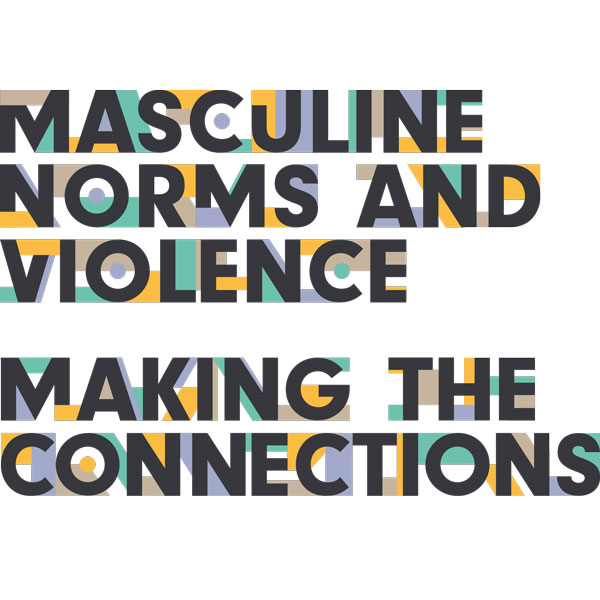
This blog is part of the Making the Connections series. Each blog focuses on one particular form of violence.
This year, Equimundo and Oak Foundation launched Masculine Norms and Violence: Making the Connections, a new report examining the links between harmful masculine norms and eight forms of violent behavior.
While there is nothing inherent about being male that drives violence, how we socialize boys into their identities as men and what we expect of them – that is, society’s masculine norms – are undeniably linked with violence. Indeed, boys and men are often raised, socialized, and encouraged to use violence in some form; on the whole, men and boys are disproportionately likely to both perpetrate most forms of violence and to die by homicide and suicide. However, the research affirms that this violence is preventable, gender equality is achievable, and nonviolent norms and ideas about manhood are prevalent and powerful.
This seventh blog in the Making the Connections series focuses on suicide. It breaks down the facts on this issue, its linkages to other forms of violence, and recommendations for action.
Suicide
The Facts
Globally, men are almost twice as likely to die by suicide as women are, with the WHO estimating that 15 men per 100,000 and eight women per 100,000 die by suicide on average, with tremendous variation by country.
While suicide is often not considered violence, 50 percent of all violent deaths for men and 71 percent of all violent deaths for women are suicides. While men are more likely to die by suicide, women are more likely to attempt suicide.
The Links
Harmful gender norms may often lie at the root of suicidal ideation and suicide. Societies that “gender” the heart such that men are told to cut off their inner lives, to repress their emotions, and to be hard-shelled workers, protectors, and lone providers contribute to a crisis of connectionamong men. Several scholars point to alexithymia – the inability to connect with and communicate one’s emotions – as a particularly male-gendered precursor to suicidal ideation.
Failure to fulfill the socially prescribed role of financial provider can drive some men in the direction of self-harm and suicide. When men are taught to be self-sufficient and independent at all costs, they may be averse to seeking mental-health services, which is also linked with suicidal behavior
The act of suicide may also be constructed as a masculine or masculinized action, which may explain why men are more likely to use more immediately fatal means such as firearms when attempting suicide.
All of these conceptual links are further supported by empirical data linking greater adherence to harmful masculine norms – whether by individual men or as expressed in mainstream culture – with increased suicidal behavior among men. In The Man Box study, young men in the United States, United Kingdom, and Mexico who most strongly agreed with harmful masculine norms were also significantly more likely to report suicidal ideation in the previous two weeks than young men who rejected those norms.
Research also shows that harmful masculine norms linked with sexual identity – particularly heteronormative and homophobic notions – are associated with increased mental-health challenges and suicide risk among individuals who identify as lesbian, gay, bisexual, transgender, intersex, or genderqueer.
The Intersections
Research on the risk factors for suicide is limited (and difficult to obtain for obvious reasons), but data suggest these risk factors include financial stress, mental health issues, alcohol abuse, and physical health issues associated with chronic pain.
Differential male-to-female suicide ratios across the globe suggest that cultural context, employment patterns and income inequality, race, ethnicity, and other demographic factors intersect with gender norms to influence suicidal ideation and behaviors.
Access to adequate healthcare, support services, and social support from family, friends, and neighbors is particularly essential in curbing men’s suicidal ideation and behavior. Yet, “gendering” of the heart and men’s cultivated emotional isolation often mean that men are unlikely to pursue formal healthcare or even to seek help and support from family and friends when they need it.
From Theory to Practice
There is increasing interest in gender-transformative approaches to address harmful gender norms in the field of suicide prevention, but most such initiatives are very new and their geographic range is limited. Initiatives aiming to prevent suicide should focus on the following transformations of harmful masculine norms:
- Identify and discuss how normative masculinities “gender” the heart, suppress emotional expression, and can lead to a sense of disconnection, isolation, and distress.
- Provide spaces for men and boys to ex- press emotions, bond with peers, and build a sense of community and belonging.
- Engage participants in discussions on traditional gender norms, the pressures of achieving manhood, and the intense – and often unrealistic – expectations these place on men and boys.
- Encourage and legitimize help-seeking behavior – including mental-health care – among men and boys.
- Explore and validate nonviolent alternative forms of masculinity.
Read the rest of the Making the Connections blog series to learn more about intimate partner violence; physical violence against children; child sexual abuse and exploitation; bullying; homicide and violent crime; non-partner sexual violence; and conflict and war.
